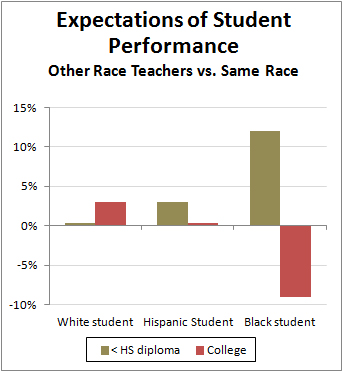Bob Somerby draws my attention to a new study about the effect of race on teacher evaluations of students. The authors took advantage of a large dataset that included evaluations of students from two teachers each. They then compared the teacher evaluations of each student based on differences in the teachers’ races.
The chart on the right tells the story. White students didn’t suffer from having a teacher of another race. Expectations of dropping out were the same and expectations of getting a college degree were actually higher. Hispanic  students were modestly affected. Teachers of other races thought Hispanic students had a slightly higher chance of dropping out and the same chance of completing college.
students were modestly affected. Teachers of other races thought Hispanic students had a slightly higher chance of dropping out and the same chance of completing college.
But black students were enormously affected. Compared to black teachers, teachers of other races thought their black students had a far higher chance of dropping out and a far lower chance of completing college. Since the baseline expectation of dropping out was 31 percent for black students, a change of 12 percentage points represents a whopping 39 percent increase. Likewise, the baseline expectation of a college degree was 37 percent for black students, so a change of 9 percentage points represents 24 percent decrease.
The authors conclude with this:
The general finding of systematic biases in teachers’ expectations for student attainment indicates that the topic of teacher expectations is ripe for future research. Particularly policy relevant areas for future inquiry include how teachers form expectations, what types of interventions can eliminate biases from teacher expectations, and how teacher expectations affect the long-run student outcomes of ultimate import. To the extent that teacher expectations affect student outcomes, the results presented in the current study provide additional support for the hiring of a more diverse and representative teaching force, as nonwhite teachers are underrepresented in U.S. public schools.
Let’s ask all our presidential candidate what, if anything, they think we should do about this.


















